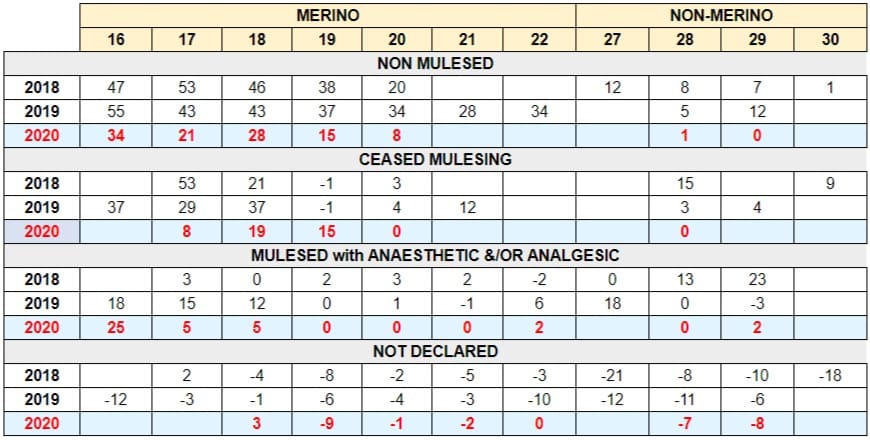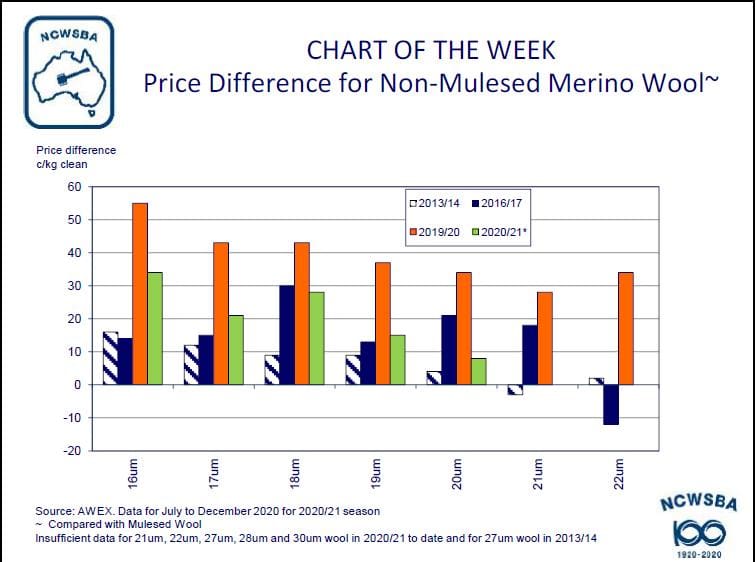 WOOL from sheep whose mulesing status is not declared has been discounted by up to 9c/kg recently and the price gap to non-mulesed wool is widening as the Australian auction market improves.
WOOL from sheep whose mulesing status is not declared has been discounted by up to 9c/kg recently and the price gap to non-mulesed wool is widening as the Australian auction market improves.
AWEX data for the six months to December 2020 has also shown that premiums for declared non-mulesed wool eased, but are now increasing as the benchmark Eastern Market Indicator lifted recently.
Sheep Central has been told premiums for non-mulesed fine Merino lines of preferred buyer specis – with good staple length, tensile strength and low vegetable matter content – have this year ranged from 10-20c/kg up to 100-200c/kg above comparable wool from sheep mulesed without pain relief.
And using mulesed without pain relief as a baseline, premiums of up to an average of 25c/kg have been paid for fine Merino wool from sheep that have been mulesed with pain relief, also referred to as analgesic/anaesthetic or AA. The AWEX premiums data is averaged to have statistical significance.

Premiums and discounts for the NWD statuses, six months to December 2020. Source – AWEX
AWEX senior market analyst Lionel Plunkett said the premiums are showing signs of widening as wool prices have lifted in the past month, but to maximise premiums, non-mulesed wool needed to be declared and “of the right micron and have the right specs, and some of the quality assurance schemes are starting to come into it as well.”
In a recent National Council of Wool Brokers of Australia newsletter, executive director Chris Wilcox discussed updated AWEX results on the average price differences paid in the 2020/21 season to the end of December for wool with the various mulesing classifications.
He said the data showed that the average premiums paid for non-mulesed Merino wool at auction in the July to December 2020 period eased a little compared with 2019/20, in line with the general decline in wool prices. He said premiums for other wool qualities such as staple length and strength have also eased, which usually happened when markets softened.
Mr Wilcox said the premium paid for non-mulesed wool by micron to December 2020 compared with the average premiums paid for the full season in 2019/20, 2016/17 and 2013/14.
“The results are statistically sound for the microns shown.
“The chart (below) shows that premiums are a little lower this season, but remain substantial,” he said.

Mr Wilcox said the highest premium for non-mulesed was paid for 16 micron wool at 34 cents/kg, and the premiums for wool from 19 micron and finer were at least 15c/kg.
“Remember that these are average price differences.
“As such, it does not show some of the much higher premiums that have been achieved for good quality, fine non-mulesed Merino wool, or for non-mulesed fine Merino wool that is sold directly from growers under contract.”
However, Mr Wilcox said the data also shows that premiums are paid for wool from properties that have ceased mulesing, with premiums of up to 19c/kg for fine Merino wool.
“As well, there were premiums paid of up to an average 25c/kg paid for wool from sheep that have been mulesed with analgesic/anaesthetic.
“The premiums disappeared for 19-21 micron wool, possibly because of the higher available volumes of this wool.”
Mr Wilcox said a highlight of the analysis was the discounts of up to 9c/kg paid in the first half of this season for wool without an NWD.
“It is well worth growers making the effort to complete an NWD.”
Trend for future contracts is for only NM/CM wool
New England Wool managing director Andrew Blanch said premiums for non-mulesed wool are more pronounced and solidified — because they are fixed — in the grower contracts that are circulating for best style superfine types.
“Premiums for NM/CM wools over similar types that are mulesed with pain relief vary, but are generally in the vicinity of +5-8pc.”
Mr Blanch said contract pricing for NM/CM wools is moving towards being the norm, and in the event that the contract does accept mulesed/AA wools, these lots receive a “discount” to the NM/CM basis prices offered.
“I expect the trend for future contracts being offered to growers, especially out of Europe, will be for only NM/CM wool with a premium built in.”
Mr Blanch suggested contract discounts mulesed/AA wools would be around 5-8pc, but added: “finding contracts that will even accept wool from mulesed sheep are few and far between.”
Brokers are keen to lift the use of the NWD
Mr Wilcox said the NCWBA is very keen to lift the use of the National Wool Declaration, “as close as possible to 100pc.”
He said NWD declarations were at 75.9pc of first offer wool up to the end of January this year, and at 77pc for Merino clips. The NWD rate for 18.6 micron and fine clips was 80pc, 18.6-24.5 micron 75pc and 24 microns and broader 68pc.
“It is even worthwhile for a crossbred grower to make a declaration.”
Mr Blanch echoed the call from Mr Wilcox for all growers to provide relevant information to the market about their wool and their farm practices.
“This is well serviced by the NWD at the very minimum.”
No NWD, no opportunity for a premium
Executive director of the Australian Council of Wool Exporters and Processor Peter Morgan said the reporting of mulesing status is important for wool exporters who have contract specifications from processor clients for wool from sheep that have not been mulesed or meet one of the other mulesing status standards.
“It is clear from AWEX data over a number of years now that there are recognised premiums for such wool.
“Exporters encourage all growers who have made the necessary changes to their management to make sure that they make maximum use of the National Wool Declaration to record the mulesing status — NM in particular, but also CM or AA — to make it easy for exporters to bid on your wool,” he said.
“There is evidence that not all growers make use of the opportunity to declare their wool, even when it qualifies for a mulesing status declaration.
“Please remember no NWD, no opportunity for a premium.”



Anyone who doesn’t make a National Wool Declaration with their wool is mad. Why not go for the possible higher price? It is the same when scoured.
A 9c/kg difference is negligible difference in reality. Also with NM wool premiums, they show that buyers aren’t truly serious with their purchasing preferences. Wool is still wool at the end of the day.
Sorry Chick, somehow we have to get past the price factor. The trade would prefer non-mulesed wool; end of story. As wool producers, we have to look at every possible way to become non-mulesed, not ways to keep mulesing. This is the main focus at the moment. Supply the market with a more desired product.
There is a lot more serious issue at the moment, and that is fly-blown sheep. I would hate think about the huge number of losses — wool damage and heartache to shearers — that are unfolding at the moment. Chemicals are losing their ability to control flies. Treating fly-blown sheep is the worst job on a farm. Why don’t wool producers want to have a flock of sheep that don’t get fly-blown?
I believe with a change in breeding attitude we could eradicate flies in Australia. Wouldn’t that be worth a red hot go? Wool doesn’t get fly-blown, diseased skin does. One of the consequences with this breeding objective would be sheep that don’t need to be mulesed. What a great side issue.
How do we get all in authority to look at change for the good of the industry, not the status quo for the individual and our peak body?
So who is stopping the National Wool Declaration being a condition of sale?